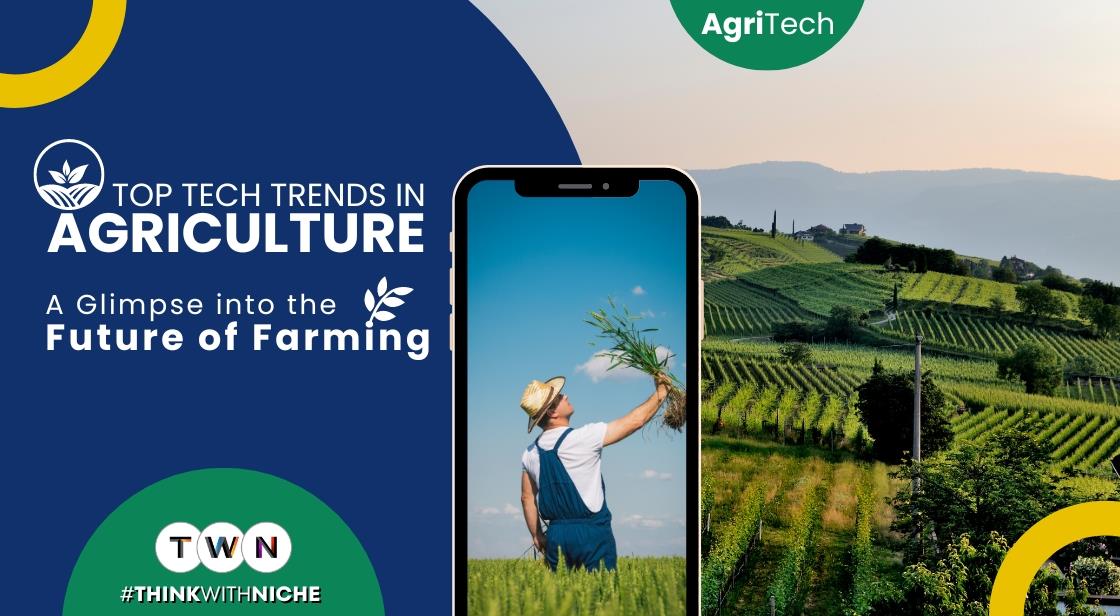Top Tech Trends in Agriculture: A Glimpse into the Future of Farming

Blog Post
The world is facing unprecedented challenges: a growing population, climate change, and dwindling resources. Agriculture, the lifeblood of our planet, needs a dramatic transformation to meet these demands.
Thankfully, a wave of technological advancements is ushering in a new era of "smart farming," promising increased productivity, sustainability, and efficiency.
From precision agriculture utilizing satellites and sensors to optimize resource use, to vertical farms stacked indoors defying space limitations, innovation is reshaping the agricultural landscape.
Drones soar overhead monitoring crop health, while AI algorithms crunch data to predict yields and identify diseases. Blockchain technology ensures transparency and traceability in food supply chains, empowering both consumers and farmers.
Consider these facts:
-
The global population is projected to reach 10 billion by 2050, placing immense pressure on our food systems.
-
Climate change threatens agricultural yields through extreme weather events and rising temperatures.
-
Traditional farming practices often contribute to environmental degradation, including soil erosion and water pollution.
These are not mere futuristic visions; they are realities already transforming farms around the globe. In India, the use of drones for crop monitoring is on the rise, while vertical farming projects are gaining momentum in urban areas.
Regenerative agriculture practices are restoring degraded land and building resilience against climate change.
The future of agriculture is not just about technology, it's about a paradigm shift. It's about recognizing the interconnectedness of our food systems with the environment, and embracing practices that nourish both.
By harnessing the power of innovation and collaboration, we can build a future where agriculture not only sustains us, but thrives alongside our planet.
Top Tech Trends in Agriculture: A Glimpse into the Future of Farming
1. Precision Agriculture
An approach to agricultural management that uses information technology to ensure that crops and soils receive what they need for optimal health and productivity. Rather than applying the same inputs across the entire region, the approach aims to manage and distribute them on a site-specific basis to maximize long-term cost benefits as well as prevent any wastage.
Like conservation agriculture, PF is a combination of different technologies rather than a lump-sum approach and allows site specific management (SSM) to use their resources efficiently and achieve economic benefits. Understanding and gaining more knowledge about natural variability within a farm is one of the important aspects of PF.
Over the past few decades, several technologies have been developed for PF; They can be divided into 'soft' and 'hard'. Soft precision agriculture relies on visual observation of crops and soil management decisions based on experience and intuition rather than statistical and scientific analysis. In contrast, hard precision agriculture uses all the modern technologies like GPS, remote sensing and variable rate technology.
Some Essential Technology Packages in Precision Farming
Essential Tech Tools for Precision Farming: Power Up Your Harvest
Precision farming, also known as smart agriculture, leverages technology to optimize crop production and resource management. Here's an expanded look at some key tech packages, beserta the latest advancements and real-world examples:
1. Satellite Positioning System (GPS):
-
Beyond Location: Modern GPS technology extends beyond basic positioning. Advanced systems like Real-Time Kinematic (RTK) offer centimeter-level accuracy, enabling precise field mapping, machinery guidance, and automated tasks.
-
Example: John Deere's AutoTrac RTK system allows tractors to automatically steer themselves, reducing overlap and saving fuel.
2. Geographic Information System (GIS):
-
Data Fusion: Modern GIS platforms integrate data from various sources, including soil maps, weather data, and yield maps, providing a holistic view of your farm's potential and challenges.
-
Example: The Bayer FieldView platform uses GIS to create "prescription maps" that guide targeted fertilizer and pesticide application, reducing waste and environmental impact.
3. Sensors (Optical and Beyond):
-
Multispectral Imaging: Drones equipped with multispectral sensors capture data beyond the visible spectrum, revealing subtle variations in crop health, nutrient deficiencies, and even pest infestations.
-
Example: Planet Labs provides satellite imagery with 3-meter resolution, helping farmers monitor large fields and identify potential issues early.
4. Remote Sensing:
-
Going Hyperspectral: Hyperspectral satellites like EnMAP offer even more detailed data, enabling precise identification of crop species, their health status, and even stress levels.
-
Example: The European Space Agency's Sentinel-2 mission provides freely available satellite imagery for various agricultural applications.
5. Variable Rate Technology (VRT):
-
AI-Powered Optimization: VRT systems are becoming increasingly sophisticated, utilizing AI and machine learning to analyze real-time data and adjust input application rates on-the-go, optimizing resource use.
-
Example: The Trimble RTX system combines GPS with AI to analyze soil maps and crop health data, automatically adjusting fertilizer application rates within a field.
6. Laser Land Leveling:
-
Precision Levelling: Modern laser land leveling systems use GPS guidance and advanced control systems to achieve high-precision leveling, ensuring optimal water distribution and irrigation efficiency.
-
Example: Topcon's laser land leveling systems are used worldwide to improve water management and boost crop yields.
7. Combine Harvesters with Yield Monitors:
-
Big Data for Informed Decisions: Yield monitors collect real-time data on crop yield variations across the field, enabling farmers to create yield maps and identify areas with high or low productivity.
-
Example: The AGCO IDEAL combine harvester integrates a yield monitor system that generates detailed yield maps, helping farmers identify areas for soil improvement or varietal selection.
8. Leaf Color Chart:
-
Simple Yet Effective: While low-tech, leaf color charts remain a valuable tool for quick and easy assessment of nitrogen levels in crops, particularly for small-scale farmers.
9. Automated Irrigation Systems:
-
Water Conservation and Precision: Drip irrigation systems with sensors and automation ensure precise water delivery to plant roots, minimizing waste and maximizing water efficiency.
-
Example: Netafim's precision irrigation systems use soil moisture sensors and automation to deliver water based on real-time needs, reducing water use by up to 30%.
Bonus Tip: Explore emerging technologies like agricultural robots, artificial intelligence, and blockchain for their potential to further revolutionize precision farming practices.
By adopting these innovative tools and staying informed about the latest advancements, you can optimize your farm's efficiency, productivity, and sustainability, reaping the rewards of a truly precision approach to agriculture.
2. Internet of things (IoT)
The tools are revolutionizing agriculture by providing real-time data on soil conditions, weather patterns and crop health. Companies like CropX offer smart sensors that monitor soil moisture levels, helping farmers make data-driven irrigation decisions.
A wide variety of technologies and devices can be linked together through the Internet of Things (IoT). The development of Internet of Things networking is a major breakthrough. This technology is used to connect all the gadgets and electronic devices through the internet.
With the help of this technology, all connected smart devices send data to each other and can receive data from each other.
Then they work on the basis of data sent to each other. At the same time, this technology is very desired in today's time and is becoming very important for the people With the help of this technology our life will become much easier in future.
With its help, you can link any device or appliance to the Internet and get any work done as per your wish from other devices.
3. Vertical Farming
Vertical farming involves using controlled growth and nutrition systems, LED lighting and layers of indoor plant growth. This type of Farming has the advantages of using less land to grow more food and avoiding chemicals. Growing food in vertical layers is known as “vertical farming.” The technique may employ hydroponic, aeroponic or soil growing techniques.
In difficult conditions, such as where arable land is scarce or unavailable, vertical farms attempt to produce food.
Types of Vertical Farming
1. Building Based Farm
Vertical farming, which was repurposed from an old meatpacking plant, often makes use of abandoned structures.
However, new construction is sometimes done to include space for vertical farming systems.
2. Shipping-Container Vertical Farms
Vertical agricultural systems are being rapidly recycled in shipping containers.
Shipping containers function as uniform, modular chambers for cultivating a range of plants, and they're often equipped with LED lighting, vertical hydroponics, intelligent climate control, and monitoring sensors.
Additionally, farms can save even more space and increase their production per unit area by stacking shipping containers.
3. Deep Farms
A vertical farm known as a “deep farm” is constructed using reclaimed mine shafts or underground tubes.
Deep fields require less energy to heat because underground temperatures and humidity are often moderate and stable.
Deep farms may also be able to save money on water supplies by using adjacent groundwater.
A deep farm can produce seven to nine times more food than a conventional farm above ground in the same area.
These subsurface farms can be completely self-sufficient when combined with automated harvesting systems.
Biotechnology and Genetic Engineering:
Advances in biotechnology and genetic engineering are enabling the development of genetically modified (GM) crops with improved resistance to pests and diseases. Adoption of Bt cotton in India, engineering it to produce insecticides,
Biotechnology and Agriculture
Biotechnology has provided the technology to create crops that have naturally occurring insect-resistant traits, making them highly resistant to pests.
Biotechnology has made selection of animals and plants with desirable traits a reality. Desirable characteristics included larger animals, and animals more resistant to disease, among others.
Example: In flower production where traits like color and scent strength are enhanced.
Benefits of Blockchain Technology for Agriculture
Blockchain technology is increasing transparency and traceability in the food supply chain. IBM Food Trust is a blockchain-based platform that allows stakeholders to track the journey of food products from farm to farm, ensuring authenticity and quality.
Blockchain technology allows peer-to-peer transactions to be carried out in a transparent manner and does not require any intermediaries such as banks (as for cryptocurrencies) or middlemen in the agricultural sector.
By eliminating the need for a central authority, the technology changes the way trust is provided – instead of trusting an authority, trust is placed in cryptography and peer-to-peer architecture. It thus helps to restore trust between producers and consumers, which can reduce transaction costs in the agri-food market.
Blockchain technology provides a reliable way to trace transactions between unknown participants. Thus fraud and malpractices can be detected immediately. Additionally, by incorporating smart contracts, problems can be reported in real time (Hewson et al., 2017; Sylvester, 2019).
This helps address the challenge of tracking products across extensive supply chains due to the complexity of the agri-food system. Thus the technology provides a solution to the issues of food quality and safety about which consumers, government etc. are highly concerned.
Blockchain technology provides transparency between all parties involved and facilitates the collection of reliable data. Blockchain can record every step in a product's value chain, from the product's creation to its death. Reliable data from the farming process is highly valuable for developing data-driven features and insurance solutions to make farming smarter and less vulnerable.
Agri-Drones for Monitoring
The use of drones for crop safety in India is new and country is increasing awareness. Indian Council of Agricultural Research (ICAR) launched a network program during September, 2021 where the use of drones and Artificial Intelligence (AI) to enhance crop growth, timely monitoring of health and manage it with increased input use efficiency.
Uses were researched. Drones and AI technology are used to monitor crop health in real time. Drones are also used for variable rate technology for pesticide and liquid fertilizer applications, water spread zone mapping, water sampling, mapping of macrophyte infestations and aquaculture management practices, etc. Drones and AI technology are also used for precision livestock farming, especially monitoring its health.
Regenerative Agriculture
An alternative to modern industrial agriculture that prioritizes land conservation and rehabilitation, tailoring practices specific to local ecosystems and climates. Like sustainable agriculture, regenerative agriculture focuses on reducing the impact of production on land, but regenerative farming goes further by actively improving soil health as well.
According to an estimate by the Food and Agriculture Organization of the United Nations (FAO), more than half of agricultural land worldwide has been degraded. Regenerative practices help in protecting farmers' livelihood, biodiversity, global food supply, and planetary health.
AI and Machine Learning Applications
Artificial intelligence (AI) and machine learning algorithms are being used for crop prediction, disease detection and yield optimization. For example, the Plantix app uses AI to identify plant diseases based on images taken by farmers.
We will take a look at some of the most promising AI technologies that are transforming the agriculture sector.
Crop and soil monitoring
Micro and macro nutrients in soil are important factors for both crop health and the quantity and quality of yield. Then, once the crops are in the soil, it is also essential to monitor the growth stages to optimize production efficiency. It is important to understand the interactions between crop growth and the environment to make adjustments for better crop health.
Observing crop maturity
Manual observation of the stages of wheat head development is one type of labor-intensive process that AI can help in precision agriculture. The researchers achieved this by collecting images of wheat at different "head" stages and in different lighting over three years, enabling them to create a "two-stage coarse-to-fine wheat ear detection system".
Insect and plant disease detection
We have seen how AI computer vision can detect and analyze crop maturity and soil quality. Using image recognition technology based on deep learning, we can now automatically detect plant diseases and pests. It works by using image classification, recognition and image segmentation methods to create models that can "track" the health of plants.
Finding bugs with code
You want to know that only are there pests in your crops, but also how many, computer vision systems for insect detection include this.
Climate-Smart Agriculture (CSA) or (Climate Resilient Agriculture)
An integrated approach to land management to help adapt farming practices, livestock and crops to the impacts of climate change and, where possible, to ensure food security, taking into account the growing world population, from agriculture The aim is to counter this by reducing greenhouse gas emissions. The emphasis is not just on carbon farming or sustainable agriculture, but also on increasing agricultural productivity.
The farm-to-table concept
1.The farm-to-table concept involves the direct sourcing of locally produced food from farms to restaurants or consumers.
2.The concept emphasizes the importance of serving fresh, seasonal and locally sourced ingredients in culinary establishments.
3.It promotes a stronger relationship between food producers and consumers, creating transparency and traceability in the food supply chain.
4.The growing popularity of farm-to-table has increased understanding of the importance of sustainable practices.
5.Sustainable practices aim to reduce negative environmental impacts, conserve natural resources, and promote social and economic well-being.
6. The farm-to-table movement strives to support local farmers and reduce food miles, so sustainable practices become important to maintain ecological balance.
Conclusion
The agriculture sector is at the forefront of innovation, with trends reshaping traditional practices and paving the way for a more sustainable and technologically advanced future. Adopting these trends not only increases productivity but also addresses the pressing challenges of feeding a growing global population while reducing environmental impact.
You May Like
EDITOR’S CHOICE












